Management Accounting - Leonard Business Services Assignment
VerifiedAdded on 2021/02/20
|17
|5021
|28
AI Summary
Contribute Materials
Your contribution can guide someone’s learning journey. Share your
documents today.
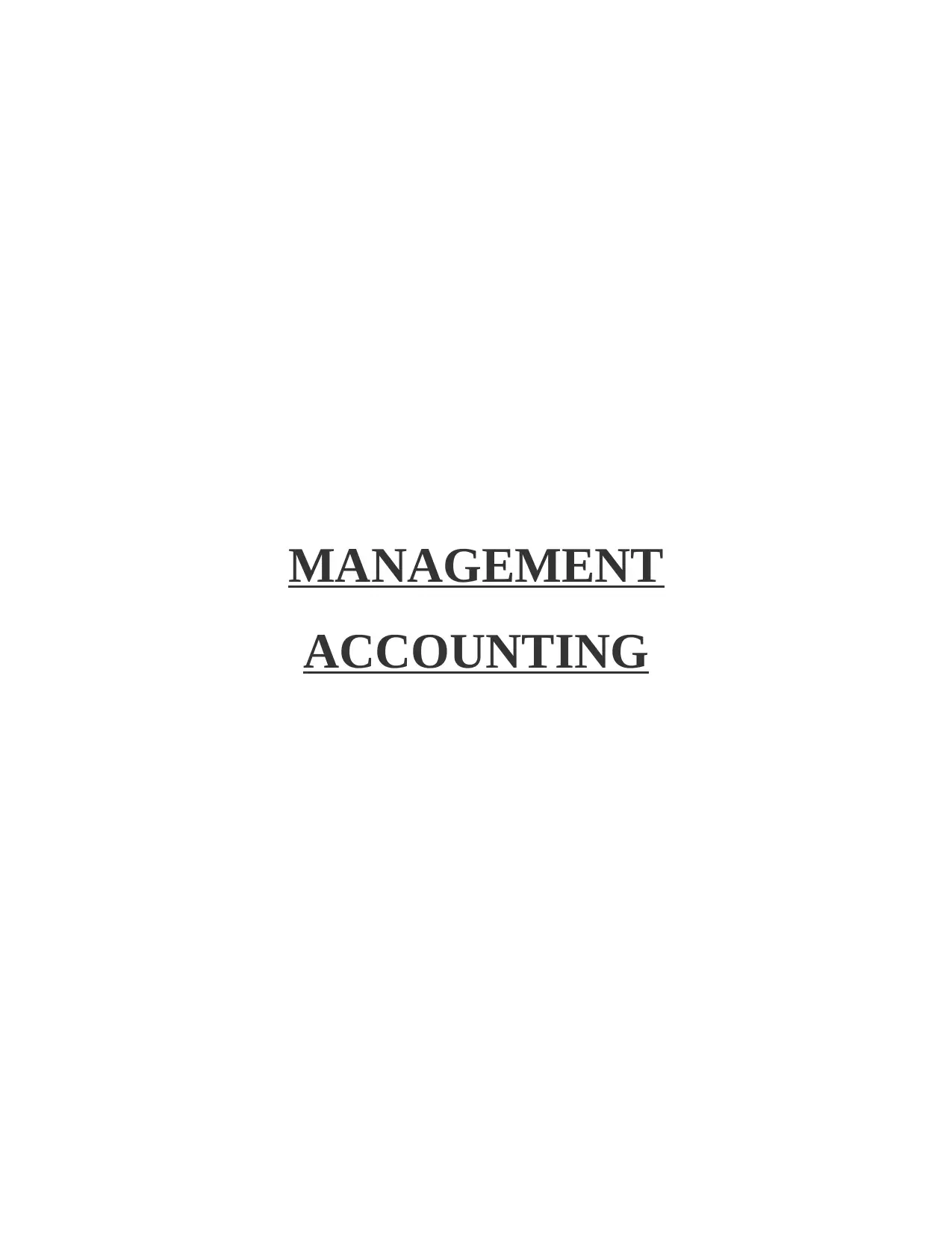
MANAGEMENT
ACCOUNTING
ACCOUNTING
Secure Best Marks with AI Grader
Need help grading? Try our AI Grader for instant feedback on your assignments.
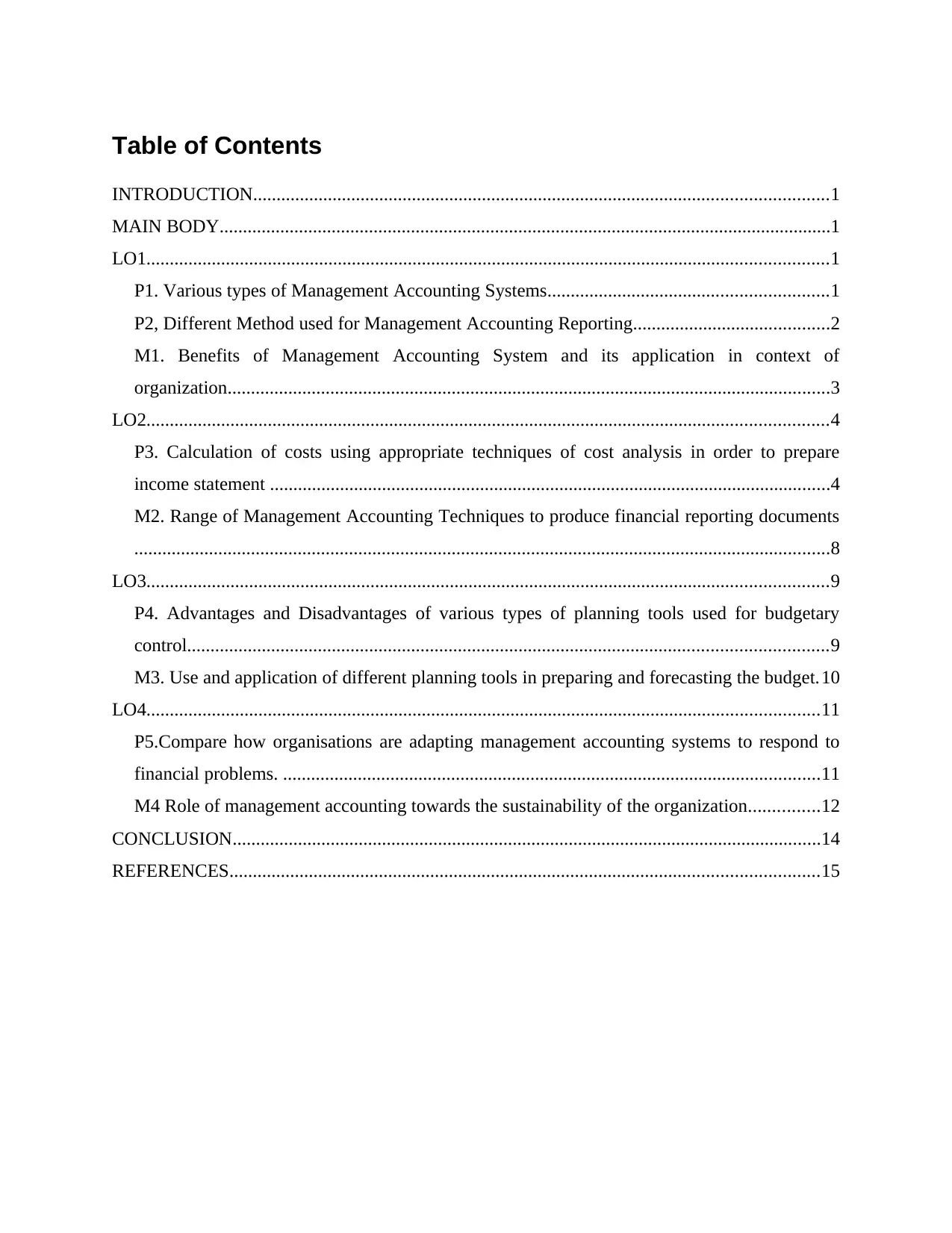
Table of Contents
INTRODUCTION...........................................................................................................................1
MAIN BODY...................................................................................................................................1
LO1..................................................................................................................................................1
P1. Various types of Management Accounting Systems............................................................1
P2, Different Method used for Management Accounting Reporting..........................................2
M1. Benefits of Management Accounting System and its application in context of
organization.................................................................................................................................3
LO2..................................................................................................................................................4
P3. Calculation of costs using appropriate techniques of cost analysis in order to prepare
income statement ........................................................................................................................4
M2. Range of Management Accounting Techniques to produce financial reporting documents
.....................................................................................................................................................8
LO3..................................................................................................................................................9
P4. Advantages and Disadvantages of various types of planning tools used for budgetary
control.........................................................................................................................................9
M3. Use and application of different planning tools in preparing and forecasting the budget.10
LO4................................................................................................................................................11
P5.Compare how organisations are adapting management accounting systems to respond to
financial problems. ...................................................................................................................11
M4 Role of management accounting towards the sustainability of the organization...............12
CONCLUSION..............................................................................................................................14
REFERENCES..............................................................................................................................15
INTRODUCTION...........................................................................................................................1
MAIN BODY...................................................................................................................................1
LO1..................................................................................................................................................1
P1. Various types of Management Accounting Systems............................................................1
P2, Different Method used for Management Accounting Reporting..........................................2
M1. Benefits of Management Accounting System and its application in context of
organization.................................................................................................................................3
LO2..................................................................................................................................................4
P3. Calculation of costs using appropriate techniques of cost analysis in order to prepare
income statement ........................................................................................................................4
M2. Range of Management Accounting Techniques to produce financial reporting documents
.....................................................................................................................................................8
LO3..................................................................................................................................................9
P4. Advantages and Disadvantages of various types of planning tools used for budgetary
control.........................................................................................................................................9
M3. Use and application of different planning tools in preparing and forecasting the budget.10
LO4................................................................................................................................................11
P5.Compare how organisations are adapting management accounting systems to respond to
financial problems. ...................................................................................................................11
M4 Role of management accounting towards the sustainability of the organization...............12
CONCLUSION..............................................................................................................................14
REFERENCES..............................................................................................................................15
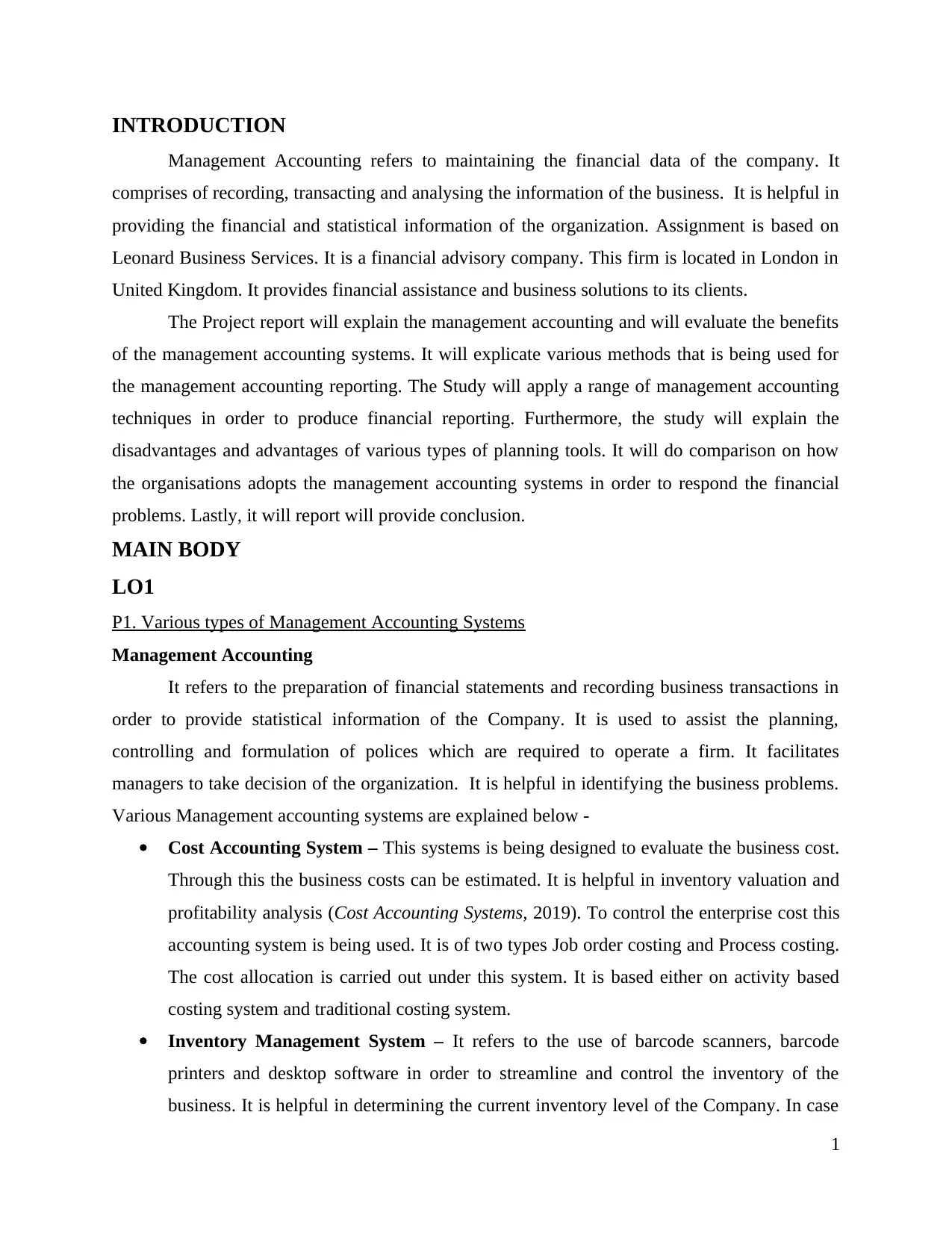
INTRODUCTION
Management Accounting refers to maintaining the financial data of the company. It
comprises of recording, transacting and analysing the information of the business. It is helpful in
providing the financial and statistical information of the organization. Assignment is based on
Leonard Business Services. It is a financial advisory company. This firm is located in London in
United Kingdom. It provides financial assistance and business solutions to its clients.
The Project report will explain the management accounting and will evaluate the benefits
of the management accounting systems. It will explicate various methods that is being used for
the management accounting reporting. The Study will apply a range of management accounting
techniques in order to produce financial reporting. Furthermore, the study will explain the
disadvantages and advantages of various types of planning tools. It will do comparison on how
the organisations adopts the management accounting systems in order to respond the financial
problems. Lastly, it will report will provide conclusion.
MAIN BODY
LO1
P1. Various types of Management Accounting Systems
Management Accounting
It refers to the preparation of financial statements and recording business transactions in
order to provide statistical information of the Company. It is used to assist the planning,
controlling and formulation of polices which are required to operate a firm. It facilitates
managers to take decision of the organization. It is helpful in identifying the business problems.
Various Management accounting systems are explained below -
Cost Accounting System – This systems is being designed to evaluate the business cost.
Through this the business costs can be estimated. It is helpful in inventory valuation and
profitability analysis (Cost Accounting Systems, 2019). To control the enterprise cost this
accounting system is being used. It is of two types Job order costing and Process costing.
The cost allocation is carried out under this system. It is based either on activity based
costing system and traditional costing system.
Inventory Management System – It refers to the use of barcode scanners, barcode
printers and desktop software in order to streamline and control the inventory of the
business. It is helpful in determining the current inventory level of the Company. In case
1
Management Accounting refers to maintaining the financial data of the company. It
comprises of recording, transacting and analysing the information of the business. It is helpful in
providing the financial and statistical information of the organization. Assignment is based on
Leonard Business Services. It is a financial advisory company. This firm is located in London in
United Kingdom. It provides financial assistance and business solutions to its clients.
The Project report will explain the management accounting and will evaluate the benefits
of the management accounting systems. It will explicate various methods that is being used for
the management accounting reporting. The Study will apply a range of management accounting
techniques in order to produce financial reporting. Furthermore, the study will explain the
disadvantages and advantages of various types of planning tools. It will do comparison on how
the organisations adopts the management accounting systems in order to respond the financial
problems. Lastly, it will report will provide conclusion.
MAIN BODY
LO1
P1. Various types of Management Accounting Systems
Management Accounting
It refers to the preparation of financial statements and recording business transactions in
order to provide statistical information of the Company. It is used to assist the planning,
controlling and formulation of polices which are required to operate a firm. It facilitates
managers to take decision of the organization. It is helpful in identifying the business problems.
Various Management accounting systems are explained below -
Cost Accounting System – This systems is being designed to evaluate the business cost.
Through this the business costs can be estimated. It is helpful in inventory valuation and
profitability analysis (Cost Accounting Systems, 2019). To control the enterprise cost this
accounting system is being used. It is of two types Job order costing and Process costing.
The cost allocation is carried out under this system. It is based either on activity based
costing system and traditional costing system.
Inventory Management System – It refers to the use of barcode scanners, barcode
printers and desktop software in order to streamline and control the inventory of the
business. It is helpful in determining the current inventory level of the Company. In case
1
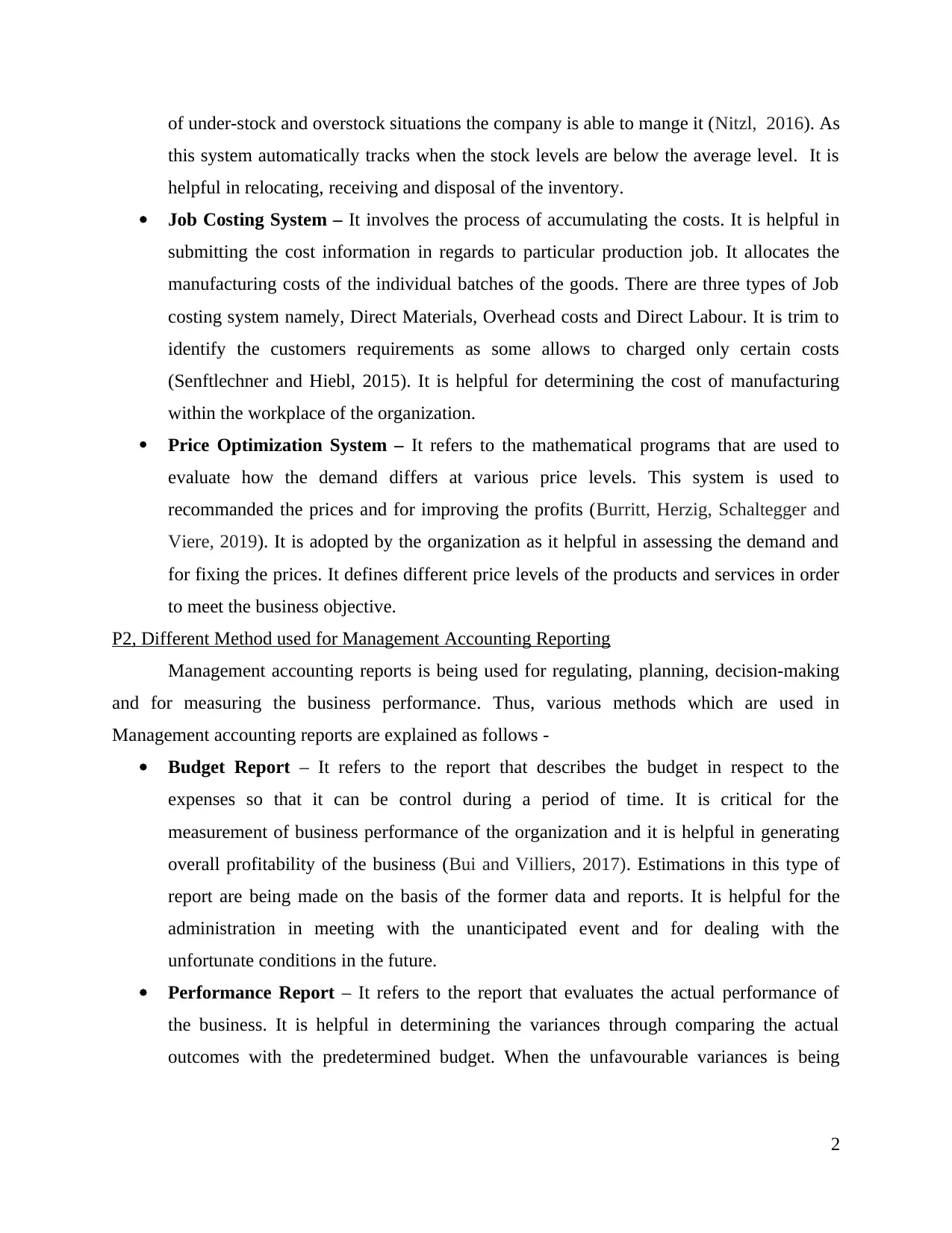
of under-stock and overstock situations the company is able to mange it (Nitzl, 2016). As
this system automatically tracks when the stock levels are below the average level. It is
helpful in relocating, receiving and disposal of the inventory.
Job Costing System – It involves the process of accumulating the costs. It is helpful in
submitting the cost information in regards to particular production job. It allocates the
manufacturing costs of the individual batches of the goods. There are three types of Job
costing system namely, Direct Materials, Overhead costs and Direct Labour. It is trim to
identify the customers requirements as some allows to charged only certain costs
(Senftlechner and Hiebl, 2015). It is helpful for determining the cost of manufacturing
within the workplace of the organization.
Price Optimization System – It refers to the mathematical programs that are used to
evaluate how the demand differs at various price levels. This system is used to
recommanded the prices and for improving the profits (Burritt, Herzig, Schaltegger and
Viere, 2019). It is adopted by the organization as it helpful in assessing the demand and
for fixing the prices. It defines different price levels of the products and services in order
to meet the business objective.
P2, Different Method used for Management Accounting Reporting
Management accounting reports is being used for regulating, planning, decision-making
and for measuring the business performance. Thus, various methods which are used in
Management accounting reports are explained as follows -
Budget Report – It refers to the report that describes the budget in respect to the
expenses so that it can be control during a period of time. It is critical for the
measurement of business performance of the organization and it is helpful in generating
overall profitability of the business (Bui and Villiers, 2017). Estimations in this type of
report are being made on the basis of the former data and reports. It is helpful for the
administration in meeting with the unanticipated event and for dealing with the
unfortunate conditions in the future.
Performance Report – It refers to the report that evaluates the actual performance of
the business. It is helpful in determining the variances through comparing the actual
outcomes with the predetermined budget. When the unfavourable variances is being
2
this system automatically tracks when the stock levels are below the average level. It is
helpful in relocating, receiving and disposal of the inventory.
Job Costing System – It involves the process of accumulating the costs. It is helpful in
submitting the cost information in regards to particular production job. It allocates the
manufacturing costs of the individual batches of the goods. There are three types of Job
costing system namely, Direct Materials, Overhead costs and Direct Labour. It is trim to
identify the customers requirements as some allows to charged only certain costs
(Senftlechner and Hiebl, 2015). It is helpful for determining the cost of manufacturing
within the workplace of the organization.
Price Optimization System – It refers to the mathematical programs that are used to
evaluate how the demand differs at various price levels. This system is used to
recommanded the prices and for improving the profits (Burritt, Herzig, Schaltegger and
Viere, 2019). It is adopted by the organization as it helpful in assessing the demand and
for fixing the prices. It defines different price levels of the products and services in order
to meet the business objective.
P2, Different Method used for Management Accounting Reporting
Management accounting reports is being used for regulating, planning, decision-making
and for measuring the business performance. Thus, various methods which are used in
Management accounting reports are explained as follows -
Budget Report – It refers to the report that describes the budget in respect to the
expenses so that it can be control during a period of time. It is critical for the
measurement of business performance of the organization and it is helpful in generating
overall profitability of the business (Bui and Villiers, 2017). Estimations in this type of
report are being made on the basis of the former data and reports. It is helpful for the
administration in meeting with the unanticipated event and for dealing with the
unfortunate conditions in the future.
Performance Report – It refers to the report that evaluates the actual performance of
the business. It is helpful in determining the variances through comparing the actual
outcomes with the predetermined budget. When the unfavourable variances is being
2
Secure Best Marks with AI Grader
Need help grading? Try our AI Grader for instant feedback on your assignments.
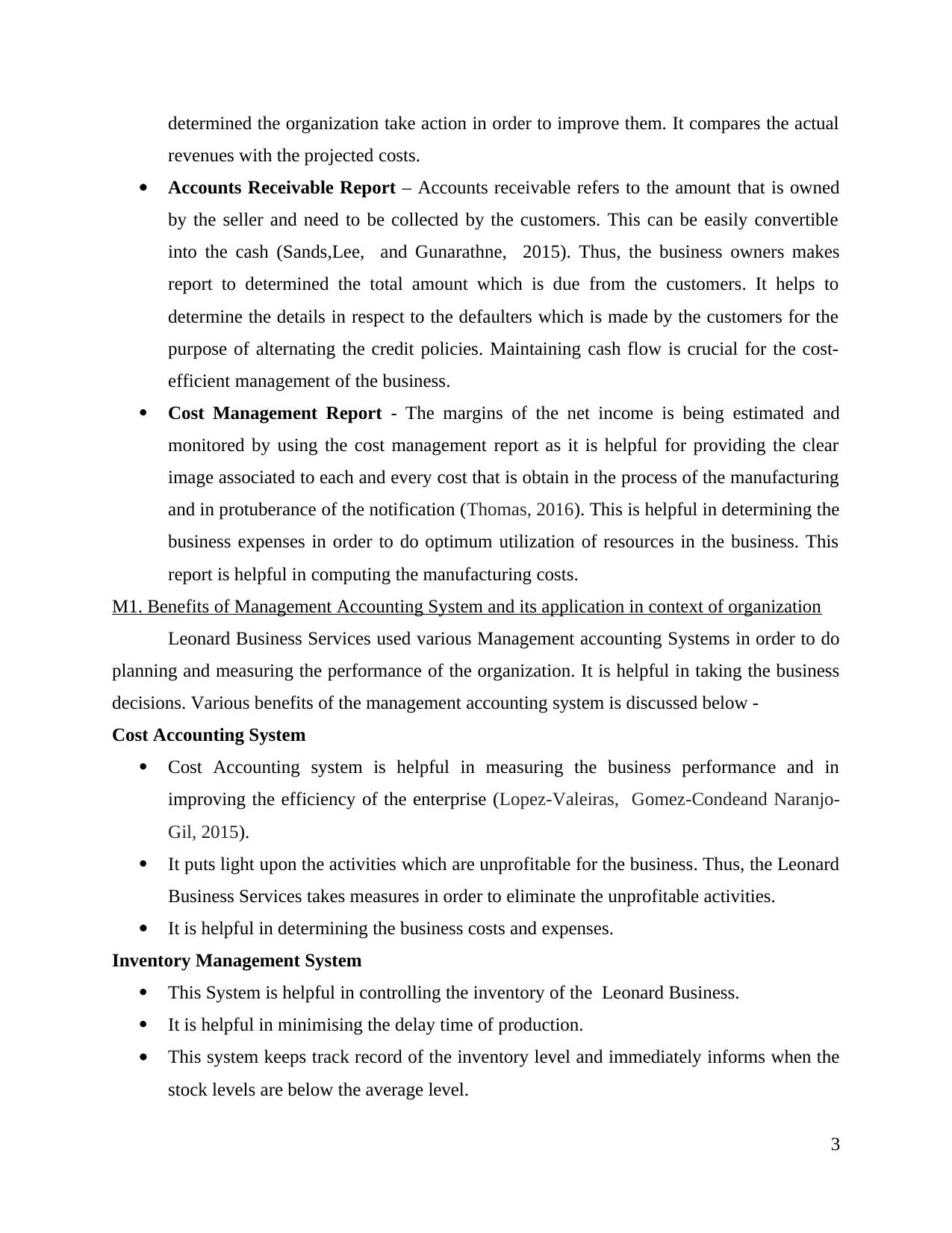
determined the organization take action in order to improve them. It compares the actual
revenues with the projected costs.
Accounts Receivable Report – Accounts receivable refers to the amount that is owned
by the seller and need to be collected by the customers. This can be easily convertible
into the cash (Sands,Lee, and Gunarathne, 2015). Thus, the business owners makes
report to determined the total amount which is due from the customers. It helps to
determine the details in respect to the defaulters which is made by the customers for the
purpose of alternating the credit policies. Maintaining cash flow is crucial for the cost-
efficient management of the business.
Cost Management Report - The margins of the net income is being estimated and
monitored by using the cost management report as it is helpful for providing the clear
image associated to each and every cost that is obtain in the process of the manufacturing
and in protuberance of the notification (Thomas, 2016). This is helpful in determining the
business expenses in order to do optimum utilization of resources in the business. This
report is helpful in computing the manufacturing costs.
M1. Benefits of Management Accounting System and its application in context of organization
Leonard Business Services used various Management accounting Systems in order to do
planning and measuring the performance of the organization. It is helpful in taking the business
decisions. Various benefits of the management accounting system is discussed below -
Cost Accounting System
Cost Accounting system is helpful in measuring the business performance and in
improving the efficiency of the enterprise (Lopez-Valeiras, Gomez-Condeand Naranjo-
Gil, 2015).
It puts light upon the activities which are unprofitable for the business. Thus, the Leonard
Business Services takes measures in order to eliminate the unprofitable activities.
It is helpful in determining the business costs and expenses.
Inventory Management System
This System is helpful in controlling the inventory of the Leonard Business.
It is helpful in minimising the delay time of production.
This system keeps track record of the inventory level and immediately informs when the
stock levels are below the average level.
3
revenues with the projected costs.
Accounts Receivable Report – Accounts receivable refers to the amount that is owned
by the seller and need to be collected by the customers. This can be easily convertible
into the cash (Sands,Lee, and Gunarathne, 2015). Thus, the business owners makes
report to determined the total amount which is due from the customers. It helps to
determine the details in respect to the defaulters which is made by the customers for the
purpose of alternating the credit policies. Maintaining cash flow is crucial for the cost-
efficient management of the business.
Cost Management Report - The margins of the net income is being estimated and
monitored by using the cost management report as it is helpful for providing the clear
image associated to each and every cost that is obtain in the process of the manufacturing
and in protuberance of the notification (Thomas, 2016). This is helpful in determining the
business expenses in order to do optimum utilization of resources in the business. This
report is helpful in computing the manufacturing costs.
M1. Benefits of Management Accounting System and its application in context of organization
Leonard Business Services used various Management accounting Systems in order to do
planning and measuring the performance of the organization. It is helpful in taking the business
decisions. Various benefits of the management accounting system is discussed below -
Cost Accounting System
Cost Accounting system is helpful in measuring the business performance and in
improving the efficiency of the enterprise (Lopez-Valeiras, Gomez-Condeand Naranjo-
Gil, 2015).
It puts light upon the activities which are unprofitable for the business. Thus, the Leonard
Business Services takes measures in order to eliminate the unprofitable activities.
It is helpful in determining the business costs and expenses.
Inventory Management System
This System is helpful in controlling the inventory of the Leonard Business.
It is helpful in minimising the delay time of production.
This system keeps track record of the inventory level and immediately informs when the
stock levels are below the average level.
3
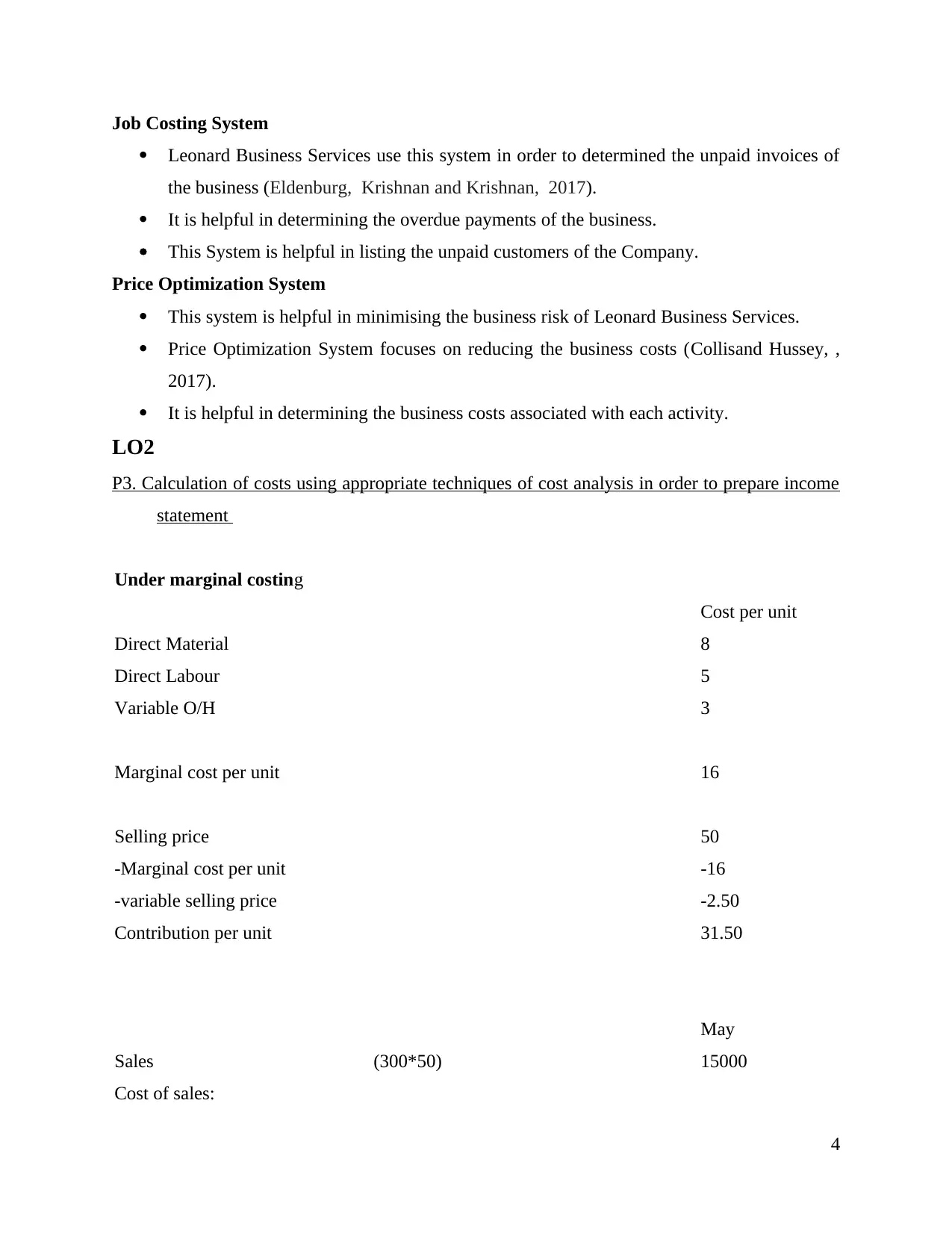
Job Costing System
Leonard Business Services use this system in order to determined the unpaid invoices of
the business (Eldenburg, Krishnan and Krishnan, 2017).
It is helpful in determining the overdue payments of the business.
This System is helpful in listing the unpaid customers of the Company.
Price Optimization System
This system is helpful in minimising the business risk of Leonard Business Services.
Price Optimization System focuses on reducing the business costs (Collisand Hussey, ,
2017).
It is helpful in determining the business costs associated with each activity.
LO2
P3. Calculation of costs using appropriate techniques of cost analysis in order to prepare income
statement
Under marginal costing
Cost per unit
Direct Material 8
Direct Labour 5
Variable O/H 3
Marginal cost per unit 16
Selling price 50
-Marginal cost per unit -16
-variable selling price -2.50
Contribution per unit 31.50
May
Sales (300*50) 15000
Cost of sales:
4
Leonard Business Services use this system in order to determined the unpaid invoices of
the business (Eldenburg, Krishnan and Krishnan, 2017).
It is helpful in determining the overdue payments of the business.
This System is helpful in listing the unpaid customers of the Company.
Price Optimization System
This system is helpful in minimising the business risk of Leonard Business Services.
Price Optimization System focuses on reducing the business costs (Collisand Hussey, ,
2017).
It is helpful in determining the business costs associated with each activity.
LO2
P3. Calculation of costs using appropriate techniques of cost analysis in order to prepare income
statement
Under marginal costing
Cost per unit
Direct Material 8
Direct Labour 5
Variable O/H 3
Marginal cost per unit 16
Selling price 50
-Marginal cost per unit -16
-variable selling price -2.50
Contribution per unit 31.50
May
Sales (300*50) 15000
Cost of sales:
4
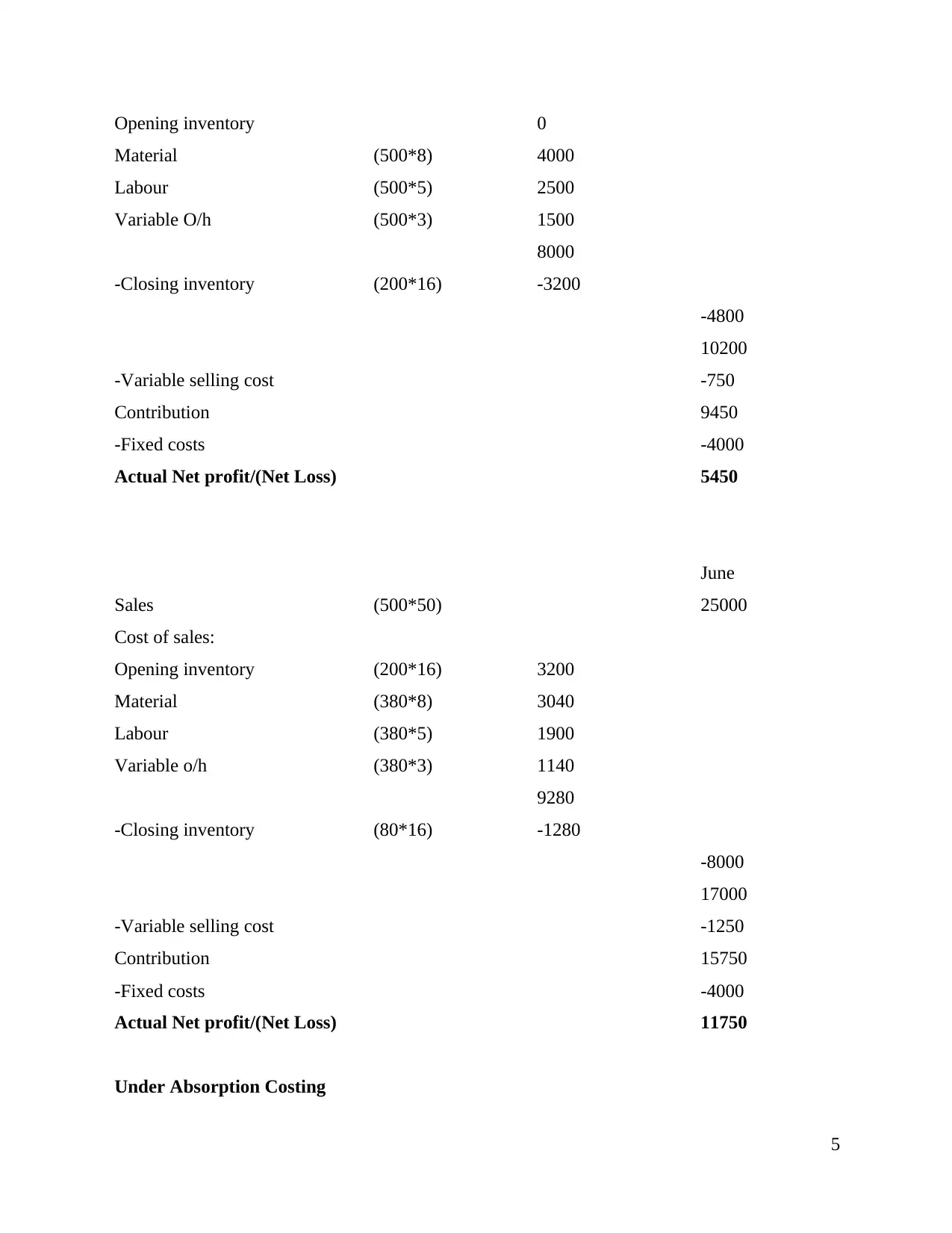
Opening inventory 0
Material (500*8) 4000
Labour (500*5) 2500
Variable O/h (500*3) 1500
8000
-Closing inventory (200*16) -3200
-4800
10200
-Variable selling cost -750
Contribution 9450
-Fixed costs -4000
Actual Net profit/(Net Loss) 5450
June
Sales (500*50) 25000
Cost of sales:
Opening inventory (200*16) 3200
Material (380*8) 3040
Labour (380*5) 1900
Variable o/h (380*3) 1140
9280
-Closing inventory (80*16) -1280
-8000
17000
-Variable selling cost -1250
Contribution 15750
-Fixed costs -4000
Actual Net profit/(Net Loss) 11750
Under Absorption Costing
5
Material (500*8) 4000
Labour (500*5) 2500
Variable O/h (500*3) 1500
8000
-Closing inventory (200*16) -3200
-4800
10200
-Variable selling cost -750
Contribution 9450
-Fixed costs -4000
Actual Net profit/(Net Loss) 5450
June
Sales (500*50) 25000
Cost of sales:
Opening inventory (200*16) 3200
Material (380*8) 3040
Labour (380*5) 1900
Variable o/h (380*3) 1140
9280
-Closing inventory (80*16) -1280
-8000
17000
-Variable selling cost -1250
Contribution 15750
-Fixed costs -4000
Actual Net profit/(Net Loss) 11750
Under Absorption Costing
5
Paraphrase This Document
Need a fresh take? Get an instant paraphrase of this document with our AI Paraphraser
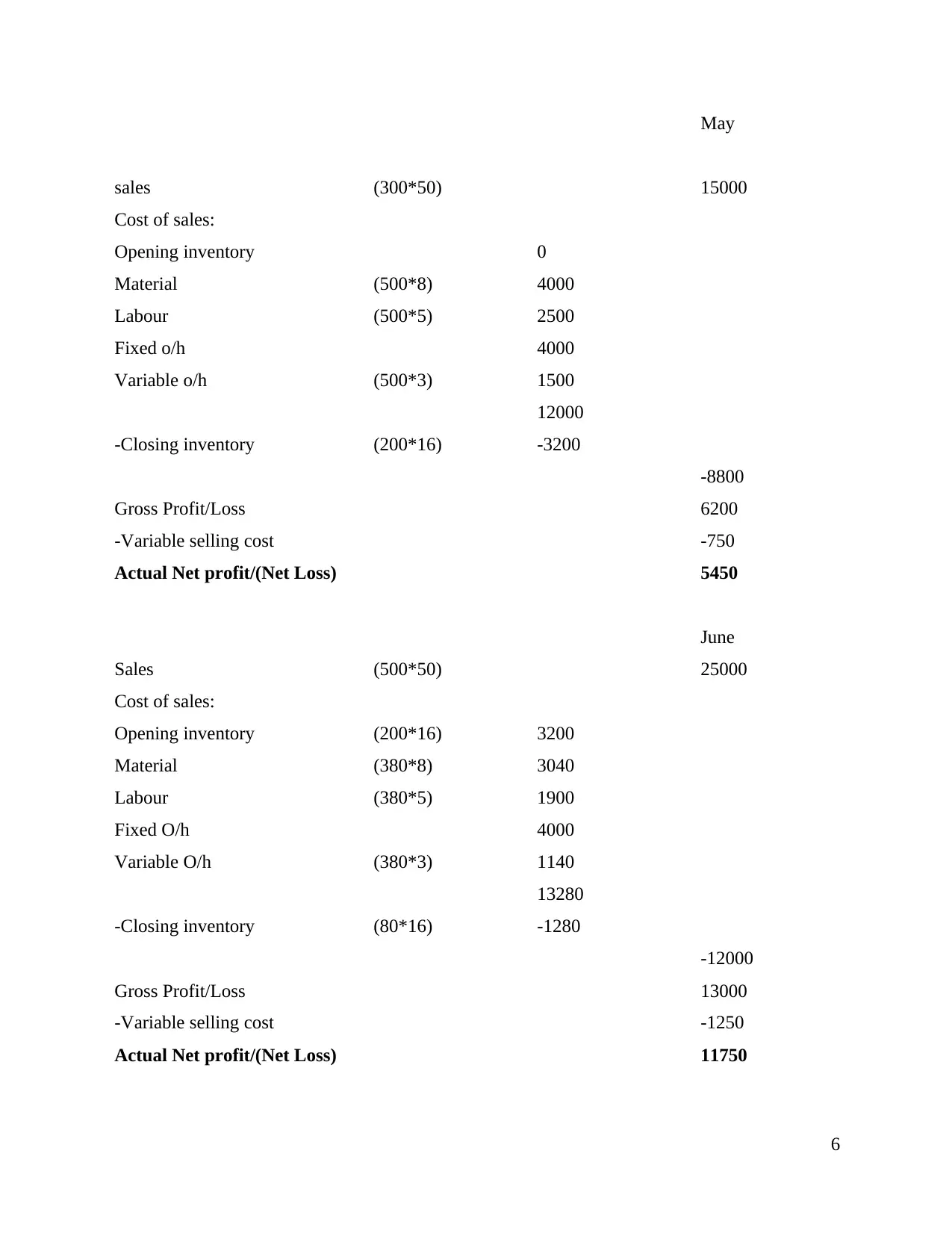
May
sales (300*50) 15000
Cost of sales:
Opening inventory 0
Material (500*8) 4000
Labour (500*5) 2500
Fixed o/h 4000
Variable o/h (500*3) 1500
12000
-Closing inventory (200*16) -3200
-8800
Gross Profit/Loss 6200
-Variable selling cost -750
Actual Net profit/(Net Loss) 5450
June
Sales (500*50) 25000
Cost of sales:
Opening inventory (200*16) 3200
Material (380*8) 3040
Labour (380*5) 1900
Fixed O/h 4000
Variable O/h (380*3) 1140
13280
-Closing inventory (80*16) -1280
-12000
Gross Profit/Loss 13000
-Variable selling cost -1250
Actual Net profit/(Net Loss) 11750
6
sales (300*50) 15000
Cost of sales:
Opening inventory 0
Material (500*8) 4000
Labour (500*5) 2500
Fixed o/h 4000
Variable o/h (500*3) 1500
12000
-Closing inventory (200*16) -3200
-8800
Gross Profit/Loss 6200
-Variable selling cost -750
Actual Net profit/(Net Loss) 5450
June
Sales (500*50) 25000
Cost of sales:
Opening inventory (200*16) 3200
Material (380*8) 3040
Labour (380*5) 1900
Fixed O/h 4000
Variable O/h (380*3) 1140
13280
-Closing inventory (80*16) -1280
-12000
Gross Profit/Loss 13000
-Variable selling cost -1250
Actual Net profit/(Net Loss) 11750
6
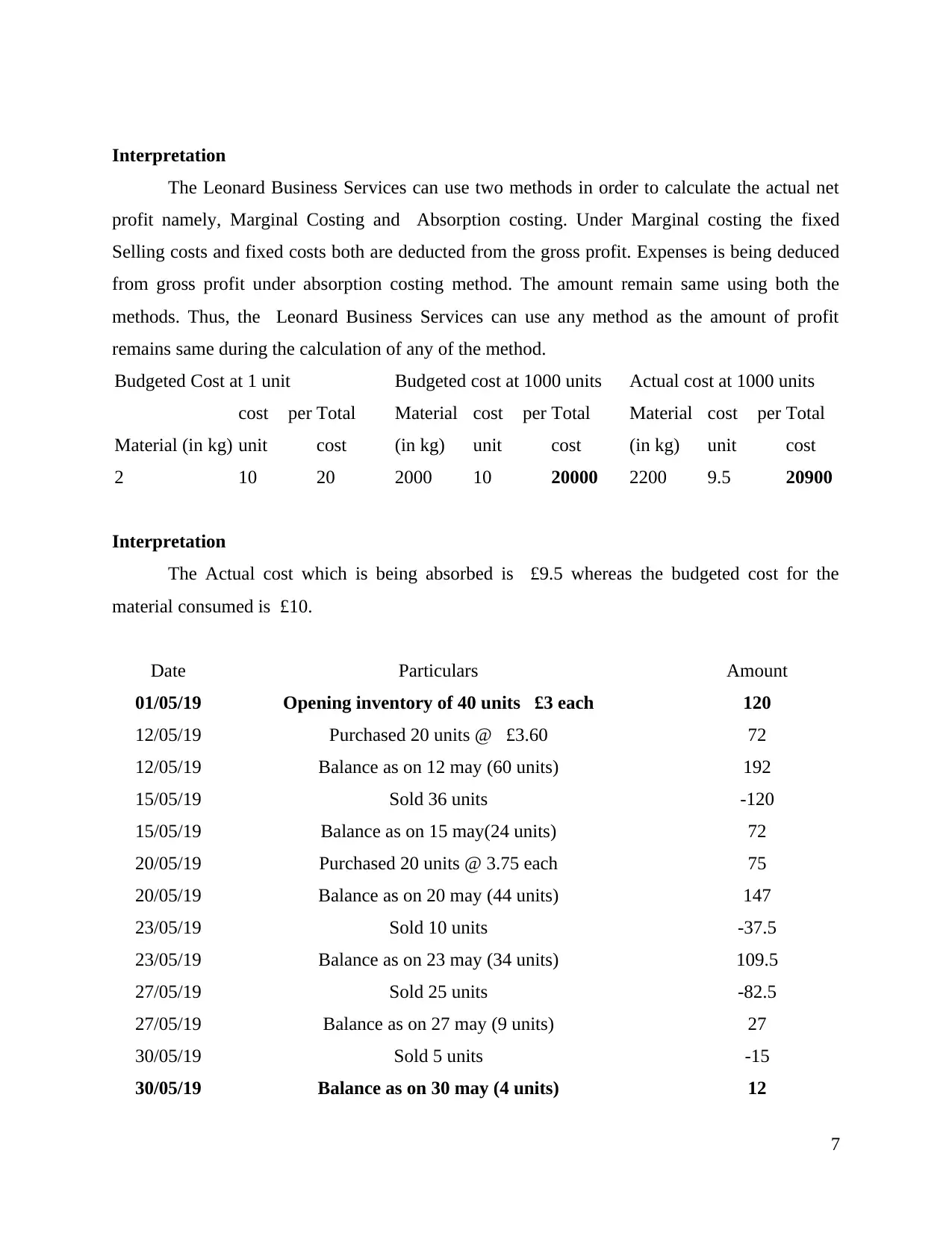
Interpretation
The Leonard Business Services can use two methods in order to calculate the actual net
profit namely, Marginal Costing and Absorption costing. Under Marginal costing the fixed
Selling costs and fixed costs both are deducted from the gross profit. Expenses is being deduced
from gross profit under absorption costing method. The amount remain same using both the
methods. Thus, the Leonard Business Services can use any method as the amount of profit
remains same during the calculation of any of the method.
Budgeted Cost at 1 unit Budgeted cost at 1000 units Actual cost at 1000 units
Material (in kg)
cost per
unit
Total
cost
Material
(in kg)
cost per
unit
Total
cost
Material
(in kg)
cost per
unit
Total
cost
2 10 20 2000 10 20000 2200 9.5 20900
Interpretation
The Actual cost which is being absorbed is £9.5 whereas the budgeted cost for the
material consumed is £10.
Date Particulars Amount
01/05/19 Opening inventory of 40 units £3 each 120
12/05/19 Purchased 20 units @ £3.60 72
12/05/19 Balance as on 12 may (60 units) 192
15/05/19 Sold 36 units -120
15/05/19 Balance as on 15 may(24 units) 72
20/05/19 Purchased 20 units @ 3.75 each 75
20/05/19 Balance as on 20 may (44 units) 147
23/05/19 Sold 10 units -37.5
23/05/19 Balance as on 23 may (34 units) 109.5
27/05/19 Sold 25 units -82.5
27/05/19 Balance as on 27 may (9 units) 27
30/05/19 Sold 5 units -15
30/05/19 Balance as on 30 may (4 units) 12
7
The Leonard Business Services can use two methods in order to calculate the actual net
profit namely, Marginal Costing and Absorption costing. Under Marginal costing the fixed
Selling costs and fixed costs both are deducted from the gross profit. Expenses is being deduced
from gross profit under absorption costing method. The amount remain same using both the
methods. Thus, the Leonard Business Services can use any method as the amount of profit
remains same during the calculation of any of the method.
Budgeted Cost at 1 unit Budgeted cost at 1000 units Actual cost at 1000 units
Material (in kg)
cost per
unit
Total
cost
Material
(in kg)
cost per
unit
Total
cost
Material
(in kg)
cost per
unit
Total
cost
2 10 20 2000 10 20000 2200 9.5 20900
Interpretation
The Actual cost which is being absorbed is £9.5 whereas the budgeted cost for the
material consumed is £10.
Date Particulars Amount
01/05/19 Opening inventory of 40 units £3 each 120
12/05/19 Purchased 20 units @ £3.60 72
12/05/19 Balance as on 12 may (60 units) 192
15/05/19 Sold 36 units -120
15/05/19 Balance as on 15 may(24 units) 72
20/05/19 Purchased 20 units @ 3.75 each 75
20/05/19 Balance as on 20 may (44 units) 147
23/05/19 Sold 10 units -37.5
23/05/19 Balance as on 23 may (34 units) 109.5
27/05/19 Sold 25 units -82.5
27/05/19 Balance as on 27 may (9 units) 27
30/05/19 Sold 5 units -15
30/05/19 Balance as on 30 may (4 units) 12
7
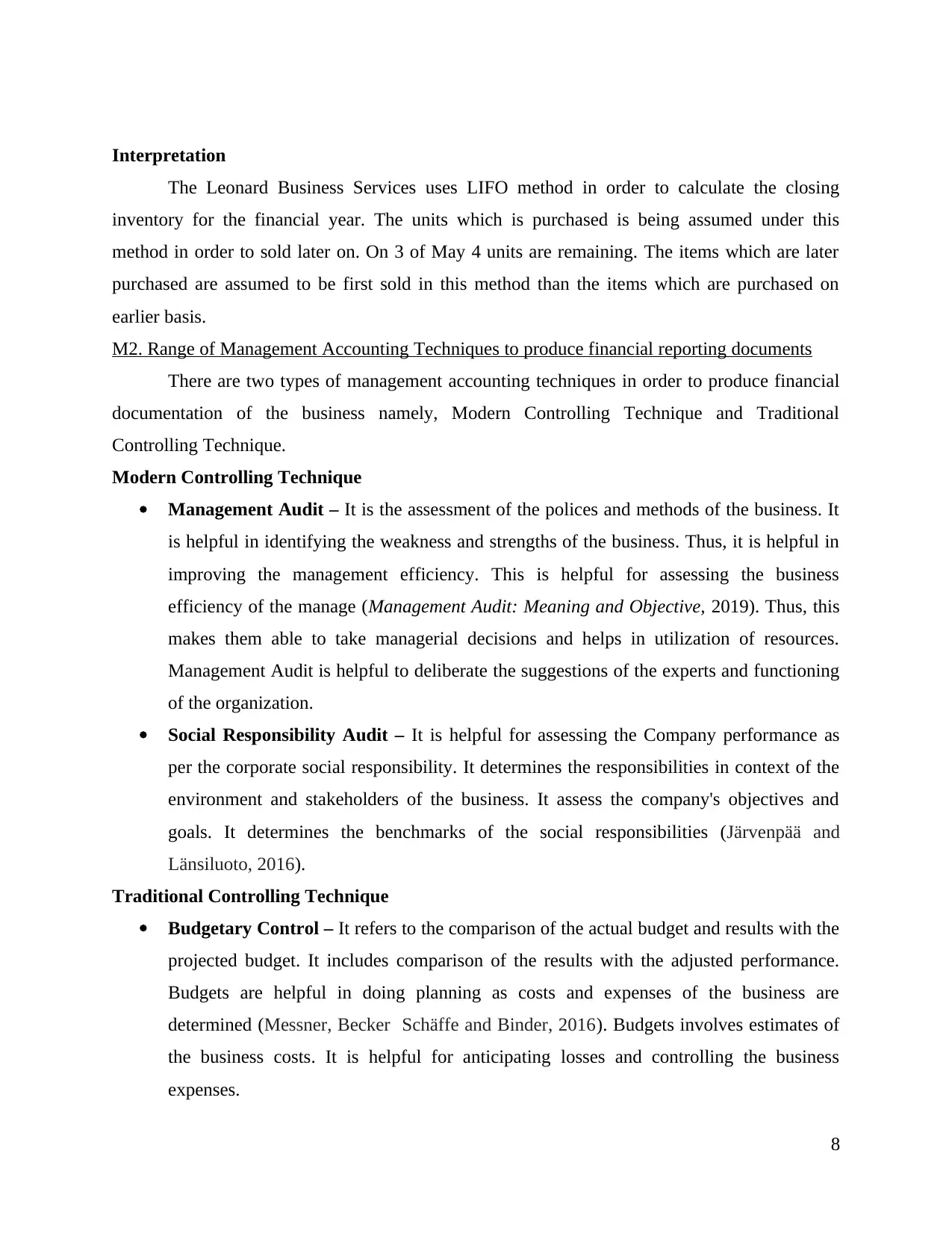
Interpretation
The Leonard Business Services uses LIFO method in order to calculate the closing
inventory for the financial year. The units which is purchased is being assumed under this
method in order to sold later on. On 3 of May 4 units are remaining. The items which are later
purchased are assumed to be first sold in this method than the items which are purchased on
earlier basis.
M2. Range of Management Accounting Techniques to produce financial reporting documents
There are two types of management accounting techniques in order to produce financial
documentation of the business namely, Modern Controlling Technique and Traditional
Controlling Technique.
Modern Controlling Technique
Management Audit – It is the assessment of the polices and methods of the business. It
is helpful in identifying the weakness and strengths of the business. Thus, it is helpful in
improving the management efficiency. This is helpful for assessing the business
efficiency of the manage (Management Audit: Meaning and Objective, 2019). Thus, this
makes them able to take managerial decisions and helps in utilization of resources.
Management Audit is helpful to deliberate the suggestions of the experts and functioning
of the organization.
Social Responsibility Audit – It is helpful for assessing the Company performance as
per the corporate social responsibility. It determines the responsibilities in context of the
environment and stakeholders of the business. It assess the company's objectives and
goals. It determines the benchmarks of the social responsibilities (Järvenpää and
Länsiluoto, 2016).
Traditional Controlling Technique
Budgetary Control – It refers to the comparison of the actual budget and results with the
projected budget. It includes comparison of the results with the adjusted performance.
Budgets are helpful in doing planning as costs and expenses of the business are
determined (Messner, Becker Schäffe and Binder, 2016). Budgets involves estimates of
the business costs. It is helpful for anticipating losses and controlling the business
expenses.
8
The Leonard Business Services uses LIFO method in order to calculate the closing
inventory for the financial year. The units which is purchased is being assumed under this
method in order to sold later on. On 3 of May 4 units are remaining. The items which are later
purchased are assumed to be first sold in this method than the items which are purchased on
earlier basis.
M2. Range of Management Accounting Techniques to produce financial reporting documents
There are two types of management accounting techniques in order to produce financial
documentation of the business namely, Modern Controlling Technique and Traditional
Controlling Technique.
Modern Controlling Technique
Management Audit – It is the assessment of the polices and methods of the business. It
is helpful in identifying the weakness and strengths of the business. Thus, it is helpful in
improving the management efficiency. This is helpful for assessing the business
efficiency of the manage (Management Audit: Meaning and Objective, 2019). Thus, this
makes them able to take managerial decisions and helps in utilization of resources.
Management Audit is helpful to deliberate the suggestions of the experts and functioning
of the organization.
Social Responsibility Audit – It is helpful for assessing the Company performance as
per the corporate social responsibility. It determines the responsibilities in context of the
environment and stakeholders of the business. It assess the company's objectives and
goals. It determines the benchmarks of the social responsibilities (Järvenpää and
Länsiluoto, 2016).
Traditional Controlling Technique
Budgetary Control – It refers to the comparison of the actual budget and results with the
projected budget. It includes comparison of the results with the adjusted performance.
Budgets are helpful in doing planning as costs and expenses of the business are
determined (Messner, Becker Schäffe and Binder, 2016). Budgets involves estimates of
the business costs. It is helpful for anticipating losses and controlling the business
expenses.
8
Secure Best Marks with AI Grader
Need help grading? Try our AI Grader for instant feedback on your assignments.
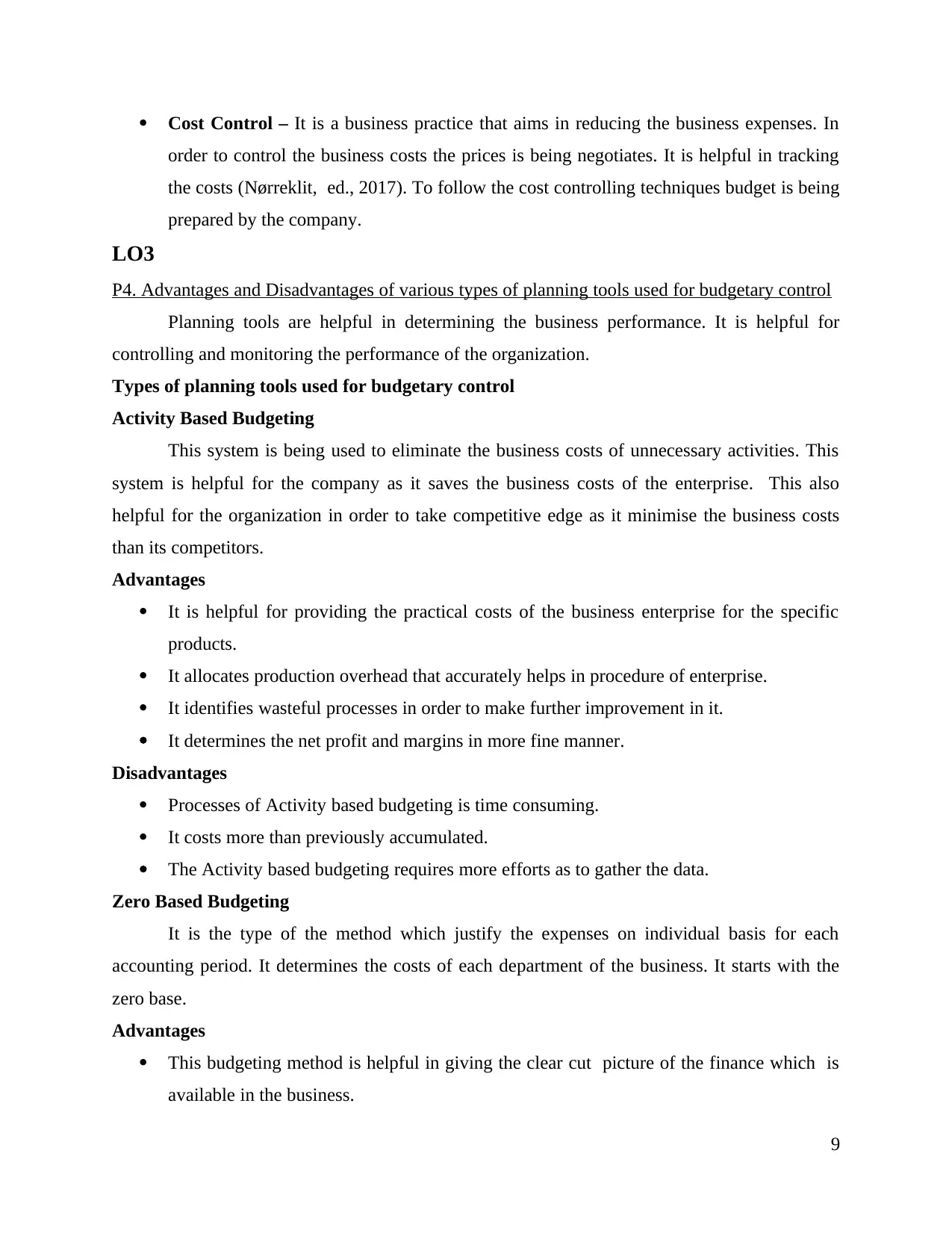
Cost Control – It is a business practice that aims in reducing the business expenses. In
order to control the business costs the prices is being negotiates. It is helpful in tracking
the costs (Nørreklit, ed., 2017). To follow the cost controlling techniques budget is being
prepared by the company.
LO3
P4. Advantages and Disadvantages of various types of planning tools used for budgetary control
Planning tools are helpful in determining the business performance. It is helpful for
controlling and monitoring the performance of the organization.
Types of planning tools used for budgetary control
Activity Based Budgeting
This system is being used to eliminate the business costs of unnecessary activities. This
system is helpful for the company as it saves the business costs of the enterprise. This also
helpful for the organization in order to take competitive edge as it minimise the business costs
than its competitors.
Advantages
It is helpful for providing the practical costs of the business enterprise for the specific
products.
It allocates production overhead that accurately helps in procedure of enterprise.
It identifies wasteful processes in order to make further improvement in it.
It determines the net profit and margins in more fine manner.
Disadvantages
Processes of Activity based budgeting is time consuming.
It costs more than previously accumulated.
The Activity based budgeting requires more efforts as to gather the data.
Zero Based Budgeting
It is the type of the method which justify the expenses on individual basis for each
accounting period. It determines the costs of each department of the business. It starts with the
zero base.
Advantages
This budgeting method is helpful in giving the clear cut picture of the finance which is
available in the business.
9
order to control the business costs the prices is being negotiates. It is helpful in tracking
the costs (Nørreklit, ed., 2017). To follow the cost controlling techniques budget is being
prepared by the company.
LO3
P4. Advantages and Disadvantages of various types of planning tools used for budgetary control
Planning tools are helpful in determining the business performance. It is helpful for
controlling and monitoring the performance of the organization.
Types of planning tools used for budgetary control
Activity Based Budgeting
This system is being used to eliminate the business costs of unnecessary activities. This
system is helpful for the company as it saves the business costs of the enterprise. This also
helpful for the organization in order to take competitive edge as it minimise the business costs
than its competitors.
Advantages
It is helpful for providing the practical costs of the business enterprise for the specific
products.
It allocates production overhead that accurately helps in procedure of enterprise.
It identifies wasteful processes in order to make further improvement in it.
It determines the net profit and margins in more fine manner.
Disadvantages
Processes of Activity based budgeting is time consuming.
It costs more than previously accumulated.
The Activity based budgeting requires more efforts as to gather the data.
Zero Based Budgeting
It is the type of the method which justify the expenses on individual basis for each
accounting period. It determines the costs of each department of the business. It starts with the
zero base.
Advantages
This budgeting method is helpful in giving the clear cut picture of the finance which is
available in the business.
9
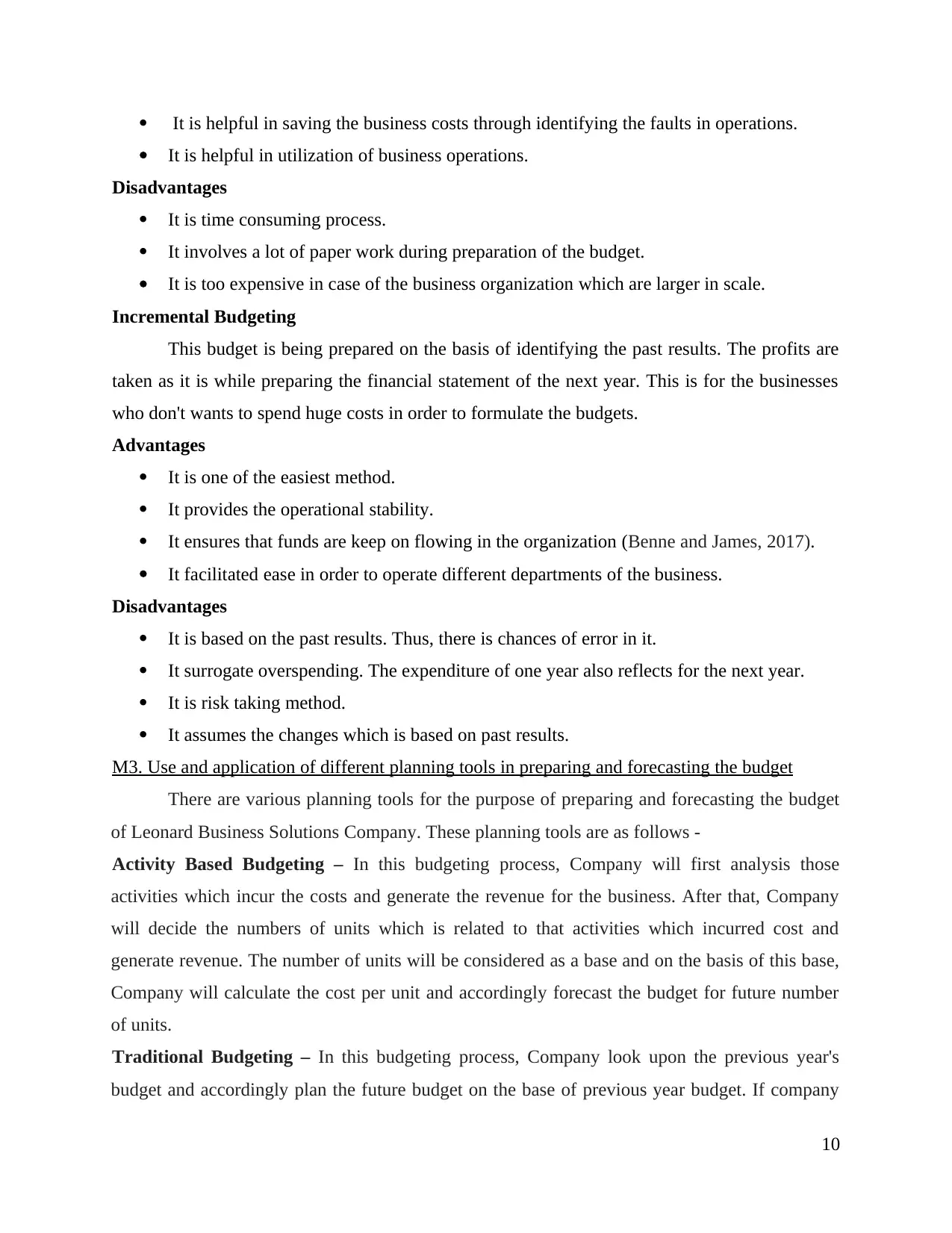
It is helpful in saving the business costs through identifying the faults in operations.
It is helpful in utilization of business operations.
Disadvantages
It is time consuming process.
It involves a lot of paper work during preparation of the budget.
It is too expensive in case of the business organization which are larger in scale.
Incremental Budgeting
This budget is being prepared on the basis of identifying the past results. The profits are
taken as it is while preparing the financial statement of the next year. This is for the businesses
who don't wants to spend huge costs in order to formulate the budgets.
Advantages
It is one of the easiest method.
It provides the operational stability.
It ensures that funds are keep on flowing in the organization (Benne and James, 2017).
It facilitated ease in order to operate different departments of the business.
Disadvantages
It is based on the past results. Thus, there is chances of error in it.
It surrogate overspending. The expenditure of one year also reflects for the next year.
It is risk taking method.
It assumes the changes which is based on past results.
M3. Use and application of different planning tools in preparing and forecasting the budget
There are various planning tools for the purpose of preparing and forecasting the budget
of Leonard Business Solutions Company. These planning tools are as follows -
Activity Based Budgeting – In this budgeting process, Company will first analysis those
activities which incur the costs and generate the revenue for the business. After that, Company
will decide the numbers of units which is related to that activities which incurred cost and
generate revenue. The number of units will be considered as a base and on the basis of this base,
Company will calculate the cost per unit and accordingly forecast the budget for future number
of units.
Traditional Budgeting – In this budgeting process, Company look upon the previous year's
budget and accordingly plan the future budget on the base of previous year budget. If company
10
It is helpful in utilization of business operations.
Disadvantages
It is time consuming process.
It involves a lot of paper work during preparation of the budget.
It is too expensive in case of the business organization which are larger in scale.
Incremental Budgeting
This budget is being prepared on the basis of identifying the past results. The profits are
taken as it is while preparing the financial statement of the next year. This is for the businesses
who don't wants to spend huge costs in order to formulate the budgets.
Advantages
It is one of the easiest method.
It provides the operational stability.
It ensures that funds are keep on flowing in the organization (Benne and James, 2017).
It facilitated ease in order to operate different departments of the business.
Disadvantages
It is based on the past results. Thus, there is chances of error in it.
It surrogate overspending. The expenditure of one year also reflects for the next year.
It is risk taking method.
It assumes the changes which is based on past results.
M3. Use and application of different planning tools in preparing and forecasting the budget
There are various planning tools for the purpose of preparing and forecasting the budget
of Leonard Business Solutions Company. These planning tools are as follows -
Activity Based Budgeting – In this budgeting process, Company will first analysis those
activities which incur the costs and generate the revenue for the business. After that, Company
will decide the numbers of units which is related to that activities which incurred cost and
generate revenue. The number of units will be considered as a base and on the basis of this base,
Company will calculate the cost per unit and accordingly forecast the budget for future number
of units.
Traditional Budgeting – In this budgeting process, Company look upon the previous year's
budget and accordingly plan the future budget on the base of previous year budget. If company
10
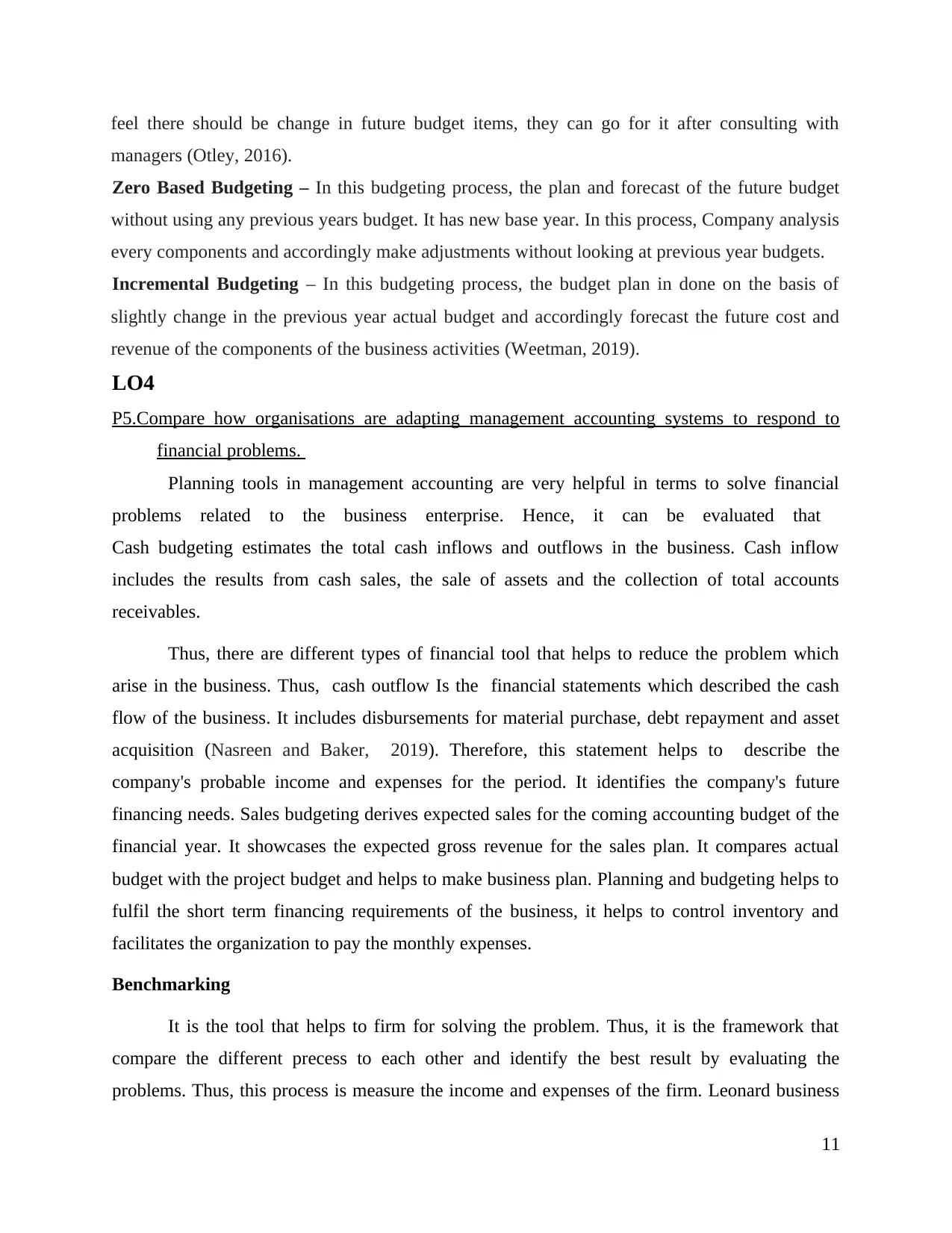
feel there should be change in future budget items, they can go for it after consulting with
managers (Otley, 2016).
Zero Based Budgeting – In this budgeting process, the plan and forecast of the future budget
without using any previous years budget. It has new base year. In this process, Company analysis
every components and accordingly make adjustments without looking at previous year budgets.
Incremental Budgeting – In this budgeting process, the budget plan in done on the basis of
slightly change in the previous year actual budget and accordingly forecast the future cost and
revenue of the components of the business activities (Weetman, 2019).
LO4
P5.Compare how organisations are adapting management accounting systems to respond to
financial problems.
Planning tools in management accounting are very helpful in terms to solve financial
problems related to the business enterprise. Hence, it can be evaluated that
Cash budgeting estimates the total cash inflows and outflows in the business. Cash inflow
includes the results from cash sales, the sale of assets and the collection of total accounts
receivables.
Thus, there are different types of financial tool that helps to reduce the problem which
arise in the business. Thus, cash outflow Is the financial statements which described the cash
flow of the business. It includes disbursements for material purchase, debt repayment and asset
acquisition (Nasreen and Baker, 2019). Therefore, this statement helps to describe the
company's probable income and expenses for the period. It identifies the company's future
financing needs. Sales budgeting derives expected sales for the coming accounting budget of the
financial year. It showcases the expected gross revenue for the sales plan. It compares actual
budget with the project budget and helps to make business plan. Planning and budgeting helps to
fulfil the short term financing requirements of the business, it helps to control inventory and
facilitates the organization to pay the monthly expenses.
Benchmarking
It is the tool that helps to firm for solving the problem. Thus, it is the framework that
compare the different precess to each other and identify the best result by evaluating the
problems. Thus, this process is measure the income and expenses of the firm. Leonard business
11
managers (Otley, 2016).
Zero Based Budgeting – In this budgeting process, the plan and forecast of the future budget
without using any previous years budget. It has new base year. In this process, Company analysis
every components and accordingly make adjustments without looking at previous year budgets.
Incremental Budgeting – In this budgeting process, the budget plan in done on the basis of
slightly change in the previous year actual budget and accordingly forecast the future cost and
revenue of the components of the business activities (Weetman, 2019).
LO4
P5.Compare how organisations are adapting management accounting systems to respond to
financial problems.
Planning tools in management accounting are very helpful in terms to solve financial
problems related to the business enterprise. Hence, it can be evaluated that
Cash budgeting estimates the total cash inflows and outflows in the business. Cash inflow
includes the results from cash sales, the sale of assets and the collection of total accounts
receivables.
Thus, there are different types of financial tool that helps to reduce the problem which
arise in the business. Thus, cash outflow Is the financial statements which described the cash
flow of the business. It includes disbursements for material purchase, debt repayment and asset
acquisition (Nasreen and Baker, 2019). Therefore, this statement helps to describe the
company's probable income and expenses for the period. It identifies the company's future
financing needs. Sales budgeting derives expected sales for the coming accounting budget of the
financial year. It showcases the expected gross revenue for the sales plan. It compares actual
budget with the project budget and helps to make business plan. Planning and budgeting helps to
fulfil the short term financing requirements of the business, it helps to control inventory and
facilitates the organization to pay the monthly expenses.
Benchmarking
It is the tool that helps to firm for solving the problem. Thus, it is the framework that
compare the different precess to each other and identify the best result by evaluating the
problems. Thus, this process is measure the income and expenses of the firm. Leonard business
11
Paraphrase This Document
Need a fresh take? Get an instant paraphrase of this document with our AI Paraphraser
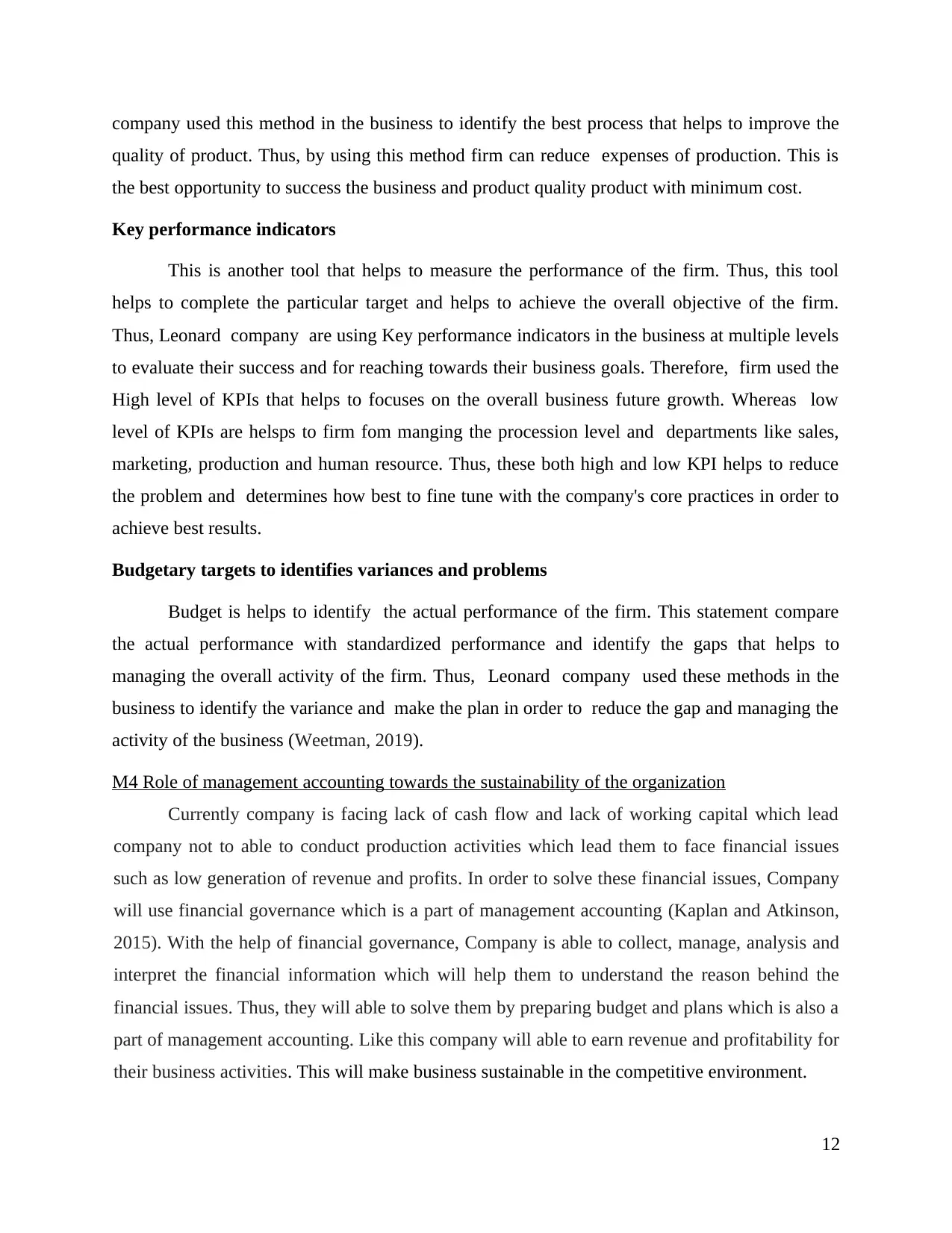
company used this method in the business to identify the best process that helps to improve the
quality of product. Thus, by using this method firm can reduce expenses of production. This is
the best opportunity to success the business and product quality product with minimum cost.
Key performance indicators
This is another tool that helps to measure the performance of the firm. Thus, this tool
helps to complete the particular target and helps to achieve the overall objective of the firm.
Thus, Leonard company are using Key performance indicators in the business at multiple levels
to evaluate their success and for reaching towards their business goals. Therefore, firm used the
High level of KPIs that helps to focuses on the overall business future growth. Whereas low
level of KPIs are helsps to firm fom manging the procession level and departments like sales,
marketing, production and human resource. Thus, these both high and low KPI helps to reduce
the problem and determines how best to fine tune with the company's core practices in order to
achieve best results.
Budgetary targets to identifies variances and problems
Budget is helps to identify the actual performance of the firm. This statement compare
the actual performance with standardized performance and identify the gaps that helps to
managing the overall activity of the firm. Thus, Leonard company used these methods in the
business to identify the variance and make the plan in order to reduce the gap and managing the
activity of the business (Weetman, 2019).
M4 Role of management accounting towards the sustainability of the organization
Currently company is facing lack of cash flow and lack of working capital which lead
company not to able to conduct production activities which lead them to face financial issues
such as low generation of revenue and profits. In order to solve these financial issues, Company
will use financial governance which is a part of management accounting (Kaplan and Atkinson,
2015). With the help of financial governance, Company is able to collect, manage, analysis and
interpret the financial information which will help them to understand the reason behind the
financial issues. Thus, they will able to solve them by preparing budget and plans which is also a
part of management accounting. Like this company will able to earn revenue and profitability for
their business activities. This will make business sustainable in the competitive environment.
12
quality of product. Thus, by using this method firm can reduce expenses of production. This is
the best opportunity to success the business and product quality product with minimum cost.
Key performance indicators
This is another tool that helps to measure the performance of the firm. Thus, this tool
helps to complete the particular target and helps to achieve the overall objective of the firm.
Thus, Leonard company are using Key performance indicators in the business at multiple levels
to evaluate their success and for reaching towards their business goals. Therefore, firm used the
High level of KPIs that helps to focuses on the overall business future growth. Whereas low
level of KPIs are helsps to firm fom manging the procession level and departments like sales,
marketing, production and human resource. Thus, these both high and low KPI helps to reduce
the problem and determines how best to fine tune with the company's core practices in order to
achieve best results.
Budgetary targets to identifies variances and problems
Budget is helps to identify the actual performance of the firm. This statement compare
the actual performance with standardized performance and identify the gaps that helps to
managing the overall activity of the firm. Thus, Leonard company used these methods in the
business to identify the variance and make the plan in order to reduce the gap and managing the
activity of the business (Weetman, 2019).
M4 Role of management accounting towards the sustainability of the organization
Currently company is facing lack of cash flow and lack of working capital which lead
company not to able to conduct production activities which lead them to face financial issues
such as low generation of revenue and profits. In order to solve these financial issues, Company
will use financial governance which is a part of management accounting (Kaplan and Atkinson,
2015). With the help of financial governance, Company is able to collect, manage, analysis and
interpret the financial information which will help them to understand the reason behind the
financial issues. Thus, they will able to solve them by preparing budget and plans which is also a
part of management accounting. Like this company will able to earn revenue and profitability for
their business activities. This will make business sustainable in the competitive environment.
12
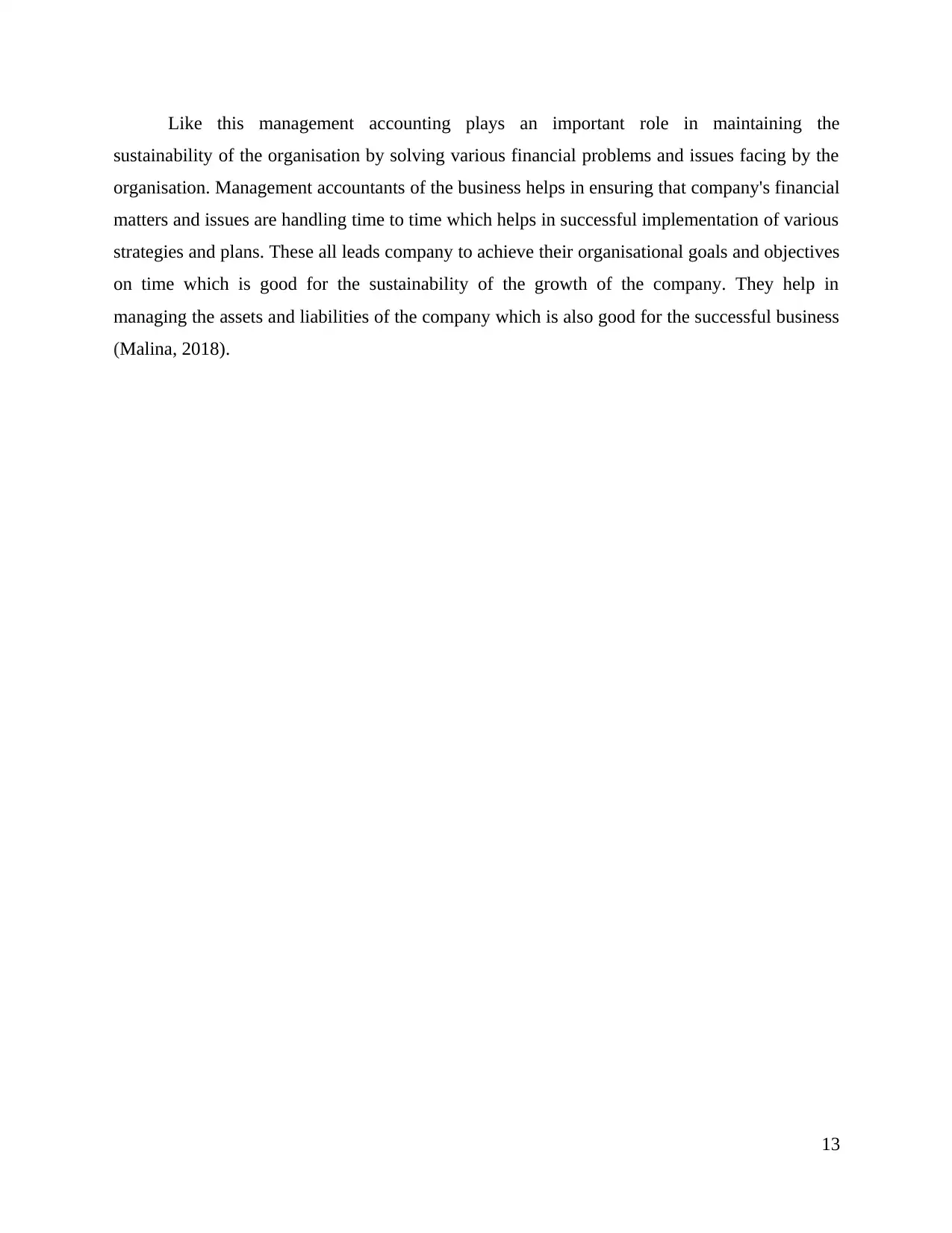
Like this management accounting plays an important role in maintaining the
sustainability of the organisation by solving various financial problems and issues facing by the
organisation. Management accountants of the business helps in ensuring that company's financial
matters and issues are handling time to time which helps in successful implementation of various
strategies and plans. These all leads company to achieve their organisational goals and objectives
on time which is good for the sustainability of the growth of the company. They help in
managing the assets and liabilities of the company which is also good for the successful business
(Malina, 2018).
13
sustainability of the organisation by solving various financial problems and issues facing by the
organisation. Management accountants of the business helps in ensuring that company's financial
matters and issues are handling time to time which helps in successful implementation of various
strategies and plans. These all leads company to achieve their organisational goals and objectives
on time which is good for the sustainability of the growth of the company. They help in
managing the assets and liabilities of the company which is also good for the successful business
(Malina, 2018).
13
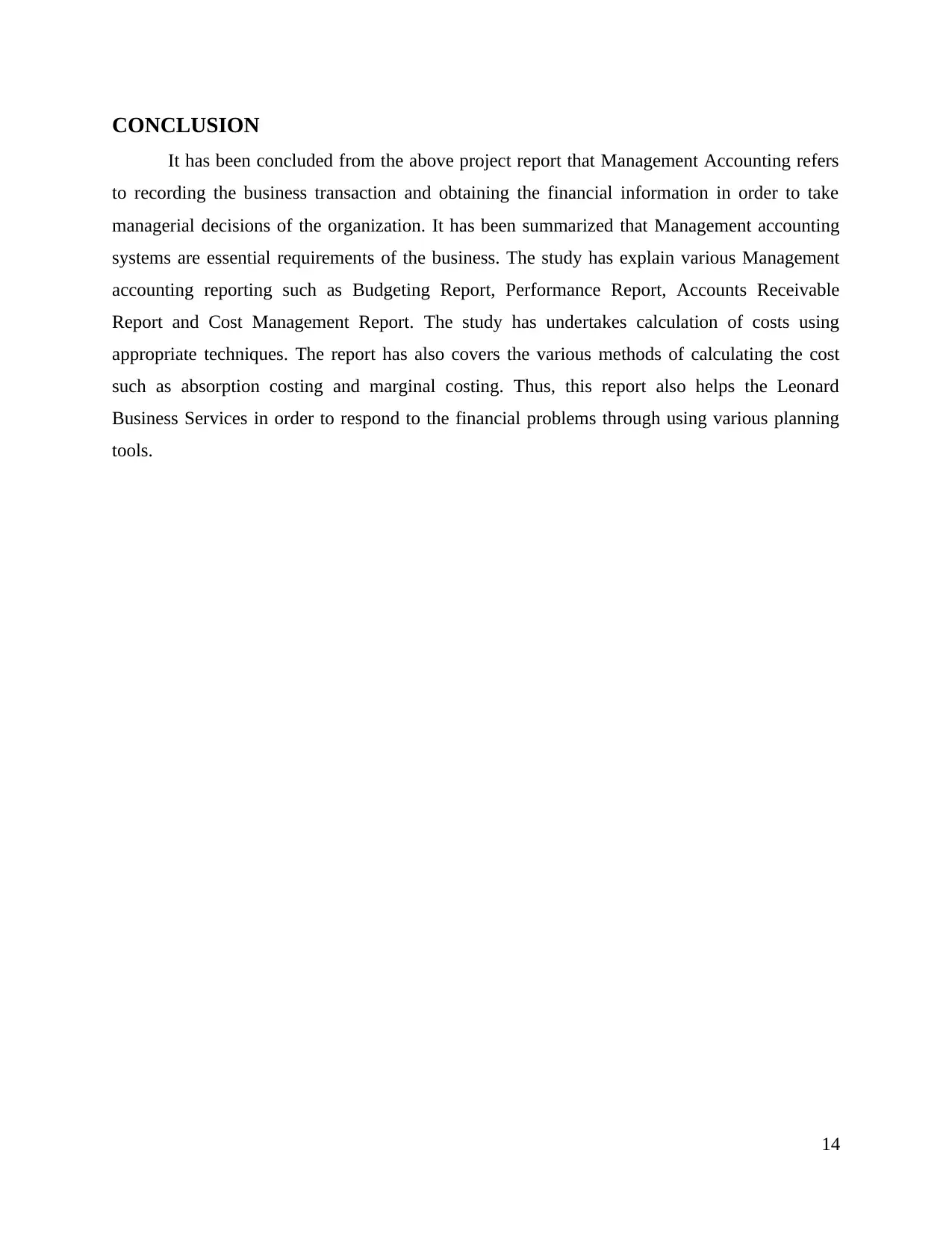
CONCLUSION
It has been concluded from the above project report that Management Accounting refers
to recording the business transaction and obtaining the financial information in order to take
managerial decisions of the organization. It has been summarized that Management accounting
systems are essential requirements of the business. The study has explain various Management
accounting reporting such as Budgeting Report, Performance Report, Accounts Receivable
Report and Cost Management Report. The study has undertakes calculation of costs using
appropriate techniques. The report has also covers the various methods of calculating the cost
such as absorption costing and marginal costing. Thus, this report also helps the Leonard
Business Services in order to respond to the financial problems through using various planning
tools.
14
It has been concluded from the above project report that Management Accounting refers
to recording the business transaction and obtaining the financial information in order to take
managerial decisions of the organization. It has been summarized that Management accounting
systems are essential requirements of the business. The study has explain various Management
accounting reporting such as Budgeting Report, Performance Report, Accounts Receivable
Report and Cost Management Report. The study has undertakes calculation of costs using
appropriate techniques. The report has also covers the various methods of calculating the cost
such as absorption costing and marginal costing. Thus, this report also helps the Leonard
Business Services in order to respond to the financial problems through using various planning
tools.
14
Secure Best Marks with AI Grader
Need help grading? Try our AI Grader for instant feedback on your assignments.
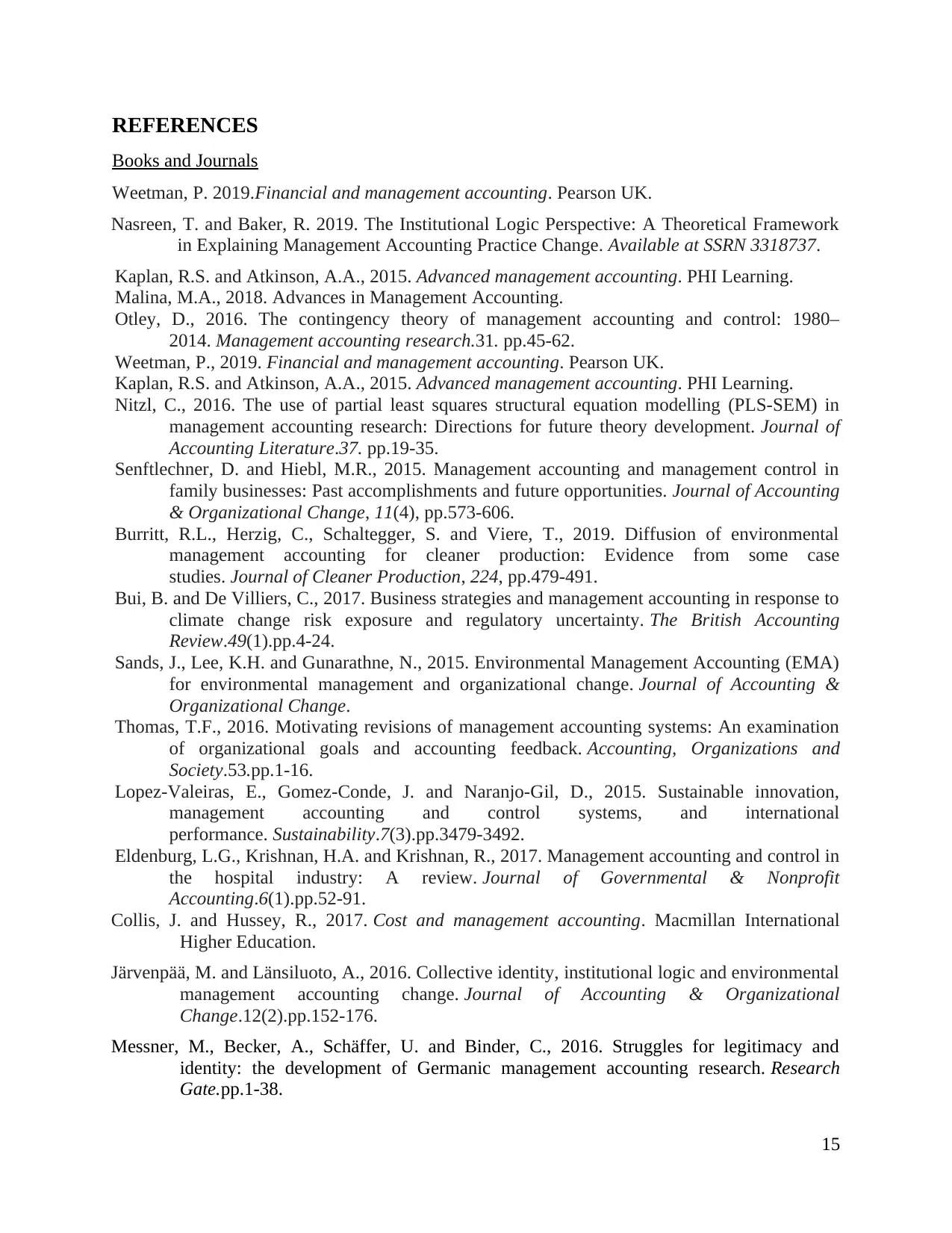
REFERENCES
Books and Journals
Weetman, P. 2019.Financial and management accounting. Pearson UK.
Nasreen, T. and Baker, R. 2019. The Institutional Logic Perspective: A Theoretical Framework
in Explaining Management Accounting Practice Change. Available at SSRN 3318737.
Kaplan, R.S. and Atkinson, A.A., 2015. Advanced management accounting. PHI Learning.
Malina, M.A., 2018. Advances in Management Accounting.
Otley, D., 2016. The contingency theory of management accounting and control: 1980–
2014. Management accounting research.31. pp.45-62.
Weetman, P., 2019. Financial and management accounting. Pearson UK.
Kaplan, R.S. and Atkinson, A.A., 2015. Advanced management accounting. PHI Learning.
Nitzl, C., 2016. The use of partial least squares structural equation modelling (PLS-SEM) in
management accounting research: Directions for future theory development. Journal of
Accounting Literature.37. pp.19-35.
Senftlechner, D. and Hiebl, M.R., 2015. Management accounting and management control in
family businesses: Past accomplishments and future opportunities. Journal of Accounting
& Organizational Change, 11(4), pp.573-606.
Burritt, R.L., Herzig, C., Schaltegger, S. and Viere, T., 2019. Diffusion of environmental
management accounting for cleaner production: Evidence from some case
studies. Journal of Cleaner Production, 224, pp.479-491.
Bui, B. and De Villiers, C., 2017. Business strategies and management accounting in response to
climate change risk exposure and regulatory uncertainty. The British Accounting
Review.49(1).pp.4-24.
Sands, J., Lee, K.H. and Gunarathne, N., 2015. Environmental Management Accounting (EMA)
for environmental management and organizational change. Journal of Accounting &
Organizational Change.
Thomas, T.F., 2016. Motivating revisions of management accounting systems: An examination
of organizational goals and accounting feedback. Accounting, Organizations and
Society.53.pp.1-16.
Lopez-Valeiras, E., Gomez-Conde, J. and Naranjo-Gil, D., 2015. Sustainable innovation,
management accounting and control systems, and international
performance. Sustainability.7(3).pp.3479-3492.
Eldenburg, L.G., Krishnan, H.A. and Krishnan, R., 2017. Management accounting and control in
the hospital industry: A review. Journal of Governmental & Nonprofit
Accounting.6(1).pp.52-91.
Collis, J. and Hussey, R., 2017. Cost and management accounting. Macmillan International
Higher Education.
Järvenpää, M. and Länsiluoto, A., 2016. Collective identity, institutional logic and environmental
management accounting change. Journal of Accounting & Organizational
Change.12(2).pp.152-176.
Messner, M., Becker, A., Schäffer, U. and Binder, C., 2016. Struggles for legitimacy and
identity: the development of Germanic management accounting research. Research
Gate.pp.1-38.
15
Books and Journals
Weetman, P. 2019.Financial and management accounting. Pearson UK.
Nasreen, T. and Baker, R. 2019. The Institutional Logic Perspective: A Theoretical Framework
in Explaining Management Accounting Practice Change. Available at SSRN 3318737.
Kaplan, R.S. and Atkinson, A.A., 2015. Advanced management accounting. PHI Learning.
Malina, M.A., 2018. Advances in Management Accounting.
Otley, D., 2016. The contingency theory of management accounting and control: 1980–
2014. Management accounting research.31. pp.45-62.
Weetman, P., 2019. Financial and management accounting. Pearson UK.
Kaplan, R.S. and Atkinson, A.A., 2015. Advanced management accounting. PHI Learning.
Nitzl, C., 2016. The use of partial least squares structural equation modelling (PLS-SEM) in
management accounting research: Directions for future theory development. Journal of
Accounting Literature.37. pp.19-35.
Senftlechner, D. and Hiebl, M.R., 2015. Management accounting and management control in
family businesses: Past accomplishments and future opportunities. Journal of Accounting
& Organizational Change, 11(4), pp.573-606.
Burritt, R.L., Herzig, C., Schaltegger, S. and Viere, T., 2019. Diffusion of environmental
management accounting for cleaner production: Evidence from some case
studies. Journal of Cleaner Production, 224, pp.479-491.
Bui, B. and De Villiers, C., 2017. Business strategies and management accounting in response to
climate change risk exposure and regulatory uncertainty. The British Accounting
Review.49(1).pp.4-24.
Sands, J., Lee, K.H. and Gunarathne, N., 2015. Environmental Management Accounting (EMA)
for environmental management and organizational change. Journal of Accounting &
Organizational Change.
Thomas, T.F., 2016. Motivating revisions of management accounting systems: An examination
of organizational goals and accounting feedback. Accounting, Organizations and
Society.53.pp.1-16.
Lopez-Valeiras, E., Gomez-Conde, J. and Naranjo-Gil, D., 2015. Sustainable innovation,
management accounting and control systems, and international
performance. Sustainability.7(3).pp.3479-3492.
Eldenburg, L.G., Krishnan, H.A. and Krishnan, R., 2017. Management accounting and control in
the hospital industry: A review. Journal of Governmental & Nonprofit
Accounting.6(1).pp.52-91.
Collis, J. and Hussey, R., 2017. Cost and management accounting. Macmillan International
Higher Education.
Järvenpää, M. and Länsiluoto, A., 2016. Collective identity, institutional logic and environmental
management accounting change. Journal of Accounting & Organizational
Change.12(2).pp.152-176.
Messner, M., Becker, A., Schäffer, U. and Binder, C., 2016. Struggles for legitimacy and
identity: the development of Germanic management accounting research. Research
Gate.pp.1-38.
15
1 out of 17
Related Documents
Your All-in-One AI-Powered Toolkit for Academic Success.
+13062052269
info@desklib.com
Available 24*7 on WhatsApp / Email
![[object Object]](/_next/static/media/star-bottom.7253800d.svg)
Unlock your academic potential
© 2024 | Zucol Services PVT LTD | All rights reserved.





